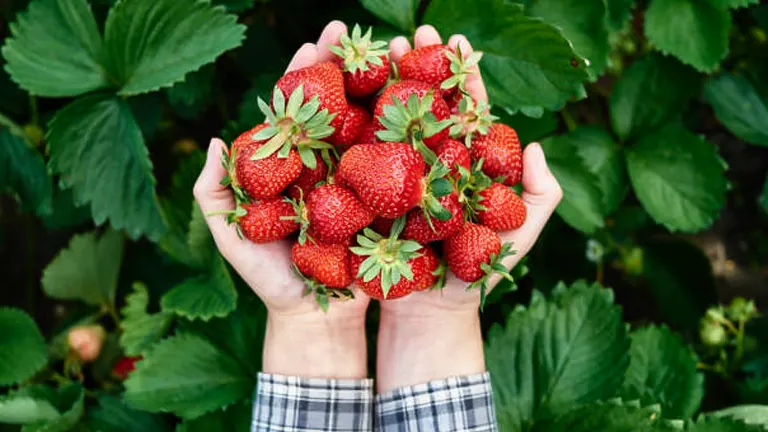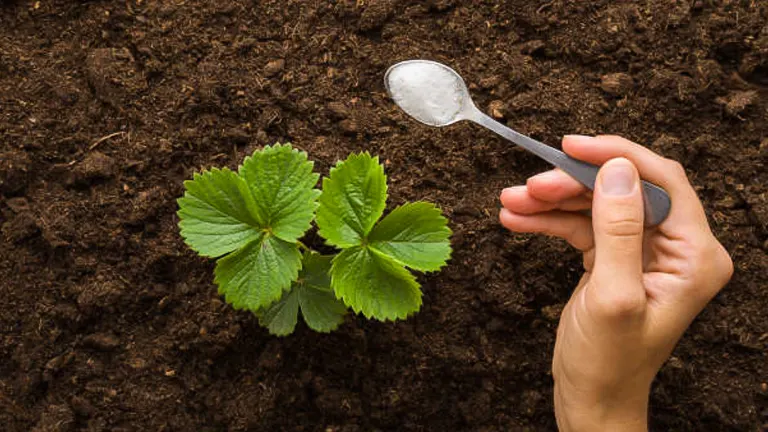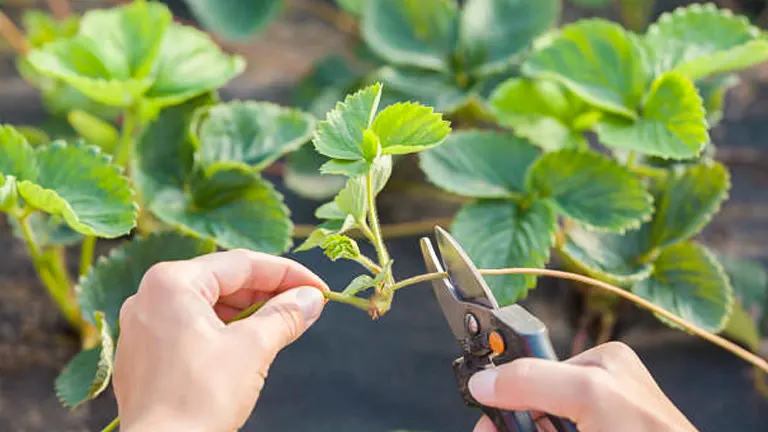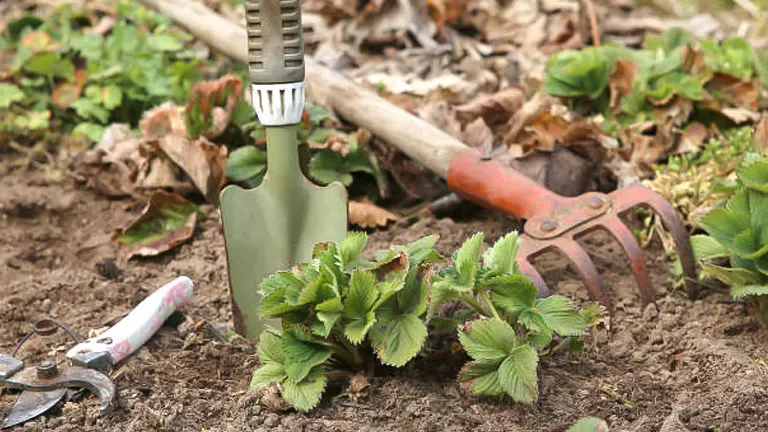How to Fertilize Your Strawberry Garden: Tips for Bigger and Better Harvests
- April 11, 2024
- 0 comment
Discover how to fertilize your strawberry garden with our expert tips for bigger, better harvests. Maximize your yield this season! Welcome to the comprehensive guide on how to fertilize your strawberry garden! Whether you are a novice gardener or an experienced grower, getting the fertilization right can significantly influence the size, taste, and health of your strawberries.

This guide will provide you with practical tips and expert advice to enhance your harvest, ensuring that your strawberries are not only bigger but also better. Read on to unlock the secrets of effective strawberry fertilization and enjoy the fruits of your labor like never before!
Table of Contents
- Understanding Strawberry Plant Nutritional Needs
- Choosing the Right Fertilizer
- Step-by-Step Guide on How on Fertilize Strawberries
- Planting and Spacing for Optimal Growth
- Pruning and Maintenance Techniques
- Advanced Nutrient Management
- Ongoing Care and Seasonal Maintenance
- Pest and Disease Management
- Advanced Growing Techniques
- Offseason Care
- Spring Preparation
- Conclusion
- FAQs
Understanding Strawberry Plant Nutritional Needs

Strawberries are demanding crops that require well-balanced nutrition to produce bountiful yields. The key macronutrients necessary for their growth are Nitrogen (N), Phosphorus (P), and Potassium (K), each serving crucial functions:
- Nitrogen (N) is vital for leaf and vegetative growth. It is the backbone of chlorophyll production, the green pigment involved in photosynthesis, and is also a major component of amino acids, the building blocks of proteins.
- Phosphorus (P) plays a pivotal role in energy transfer; it is necessary for photosynthesis and the transformation of solar energy into chemical energy, which fuels fruit production and root development.
- Potassium (K), known as the “quality nutrient,” regulates water use and improves the plant’s disease resistance, enzyme activation, and overall health.
Balancing these nutrients is essential not only for the health of the plants but also for maximizing the yield and quality of the strawberries.
Recognizing Nutritional Deficiencies
- Nitrogen Deficiency: Pale, yellowish leaves and stunted growth indicate a lack of nitrogen. This can lead to diminished vigor and lower yields.
- Phosphorus Deficiency: Signs include dark, bluish-green foliage and a reduction in the number and size of fruit. It can also cause the plants to mature at a slower pace.
- Potassium Deficiency: Symptoms manifest as yellowing of leaf edges and scorched tips, combined with weak stems and reduced resistance to pests and diseases.
Scientific Analysis and Nutrient Ratios
For those interested in the precise management of strawberry nutrition, consider the following NPK ratios based on scientific research:
| Nutrient | Ideal Ratio | Function | Deficiency Symptoms |
|---|---|---|---|
| Nitrogen (N) | 1-1-1 | Supports foliage growth and is essential for the formation of chlorophyll. | Pale, yellowish leaves, slower growth rates. |
| Phosphorus (P) | 1-2-1 | Crucial for root development and helps set flowers and fruits. | Dark, bluish-green foliage, reduced flowering and fruit set. |
| Potassium (K) | 1-1-2 | Regulates water use, improves drought resistance, and enhances disease resistance and fruit quality. | Browning leaf edges, weak stems, increased susceptibility to pests and diseases. |
Explanation of Ratios:
- Nitrogen (N): The 1-1-1 ratio suggests a balanced approach, ideal for general maintenance when plants are established but not yet blooming heavily.
- Phosphorus (P): The 1-2-1 ratio boosts phosphorus relative to nitrogen and potassium to promote strong root development and a robust flowering phase.
- Potassium (K): Increasing potassium to a 1-1-2 ratio supports the plant’s ability to resist disease, manage drought stress better, and produce high-quality fruits.
Advanced Tips
- Utilize slow-release fertilizers to provide a steady supply of nutrients, which is especially beneficial during the peak growing season.
- Incorporate organic matter such as compost or manure into the soil to improve its structure and nutrient content, which, in turn, enhances root health and water/nutrient uptake.
- Monitor soil pH regularly, aiming for a slightly acidic range (pH 5.5-6.5), as this optimizes nutrient availability and uptake.
Choosing the Right Fertilizer

Selecting an appropriate fertilizer is crucial for the health and productivity of strawberry plants and involves understanding the specific needs of the crop and the benefits of different types of fertilizers.
Organic vs. Synthetic Fertilizers
- Organic Fertilizers: These include natural materials like compost, manure, bone meal, and others, which release nutrients slowly and improve soil health over time.
- Benefits: Enhances soil structure, promotes microbial activity, environmentally sustainable.
- Drawbacks: Nutrient release is slower and less predictable, potentially lower nutrient concentrations initially.
- Synthetic Fertilizers: These are manufactured products that provide nutrients in precise ratios, available immediately to the plants.
- Benefits: Quick nutrient release, exact nutrient ratios, immediate impact.
- Drawbacks: Higher risk of over-fertilization, potential for environmental runoff, can degrade soil health over time.
Ideal NPK Ratios for Strawberries
- Nitrogen (N): A lower ratio is often sufficient, as excessive nitrogen can lead to vigorous foliage growth at the expense of fruit production.
- Phosphorus (P): Essential for root development and bloom production; a slightly higher ratio can promote more abundant and healthier blooms.
- Potassium (K): Similar to nitrogen, but important for overall plant health and fruit quality.
| Element | Scientific Recommendation | Role in Strawberry Care | Optimal Concentration Range |
|---|---|---|---|
| Nitrogen (N) | Lower to moderate | Leaf and stem growth, chlorophyll production | 5-10% |
| Phosphorus (P) | Moderate to high | Root development, flower and fruit production | 10-20% |
| Potassium (K) | Moderate | Water regulation, disease resistance | 5-15% |
Advanced Fertilization Techniques:
- Soil Testing: Essential to determine the current nutrient content and pH level, allowing for more precise fertilizer application.
- Micronutrient Management: Although NPK are the primary nutrients, strawberries also benefit from magnesium (Mg), calcium (Ca), and iron (Fe) for full health.
- Application Method: Fertilizers should be applied based on the plant’s growth cycle, with lighter applications during the early growth stages and more generous applications as the plants mature and enter the fruiting phase.
Environmental Considerations
- Microclimate Management: Pay attention to the specific conditions of your garden area, including sunlight, wind, and moisture levels, which can influence fertilizer needs.
- Rainfall and Irrigation: Adjust fertilization based on rainfall; more water requires more frequent fertilization due to nutrient leaching.
- Local Soil Conditions: Tailor your fertilization strategy to the specific conditions of your soil, which might differ even within small geographic areas.
Step-by-Step Guide on How to Fertilize Strawberries
Step 1: Conduct a Detailed Soil Analysis
- Timing: Perform a soil test early in the spring before planting or after the growing season in preparation for the next year.
- Objective: Determine your soil’s pH level and nutrient composition. Strawberries prefer slightly acidic soil (pH 5.5-6.5).
- Action: Adjust the soil pH if necessary by applying lime to raise the pH or sulfur to lower it, based on the test results.
Step 2: Select the Appropriate Fertilizer
- Organic vs. Synthetic: Decide whether you’ll use organic fertilizers, like compost or manure, which improve soil health over time, or synthetic fertilizers, which can provide a more immediate nutrient supply.
- Formulation: Choose a fertilizer with an NPK ratio that matches your soil’s needs. A general recommendation for strawberries is a balanced 10-10-10 formula. However, the exact formulation should be tailored based on soil test results.
Step 3: Pre-Planting Fertilization
- Application: If starting a new bed, mix the recommended amount of fertilizer into the soil to a depth of 6-8 inches, a few weeks before planting. This helps establish a nutrient-rich foundation for your plants.
Step 4: Fertilizing at Planting
- Method: When planting strawberries, apply a starter solution of high-phosphorus fertilizer to promote root growth. You can make a starter solution by dissolving a water-soluble fertilizer in water according to package instructions and watering it in around the new plants.
Step 5: Regular Fertilization Schedule
- First Year: Avoid high-nitrogen fertilizers during the first year to prevent excessive leaf growth over fruit production. Instead, focus on phosphorus to encourage strong root development.
- Subsequent Years: Apply a balanced fertilizer in early spring as new growth appears. Follow up with additional light applications every 4 to 6 weeks through the growing season, stopping before the end of July to avoid promoting growth that won’t survive winter.
Step 6: Adjusting Fertilization Based on Observations
- Monitoring: Throughout the growing season, watch your plants for signs of nutrient deficiency or excess. Adjust your fertilization practices based on plant performance and appearance.
- Feedback Loop: Use leaf color, plant vigor, and fruit quality as indicators of your fertilization strategy’s effectiveness. Make adjustments as needed, and consider another soil test to refine your approach.
Step 7: Post-Harvest Fertilization
- Purpose: After the final harvest, applying a potassium-rich fertilizer can help prepare plants for the winter and improve disease resistance.
- Caution: Avoid nitrogen-rich fertilizers late in the season, as they can stimulate new growth susceptible to winter kill.
Step 8: Record Keeping and Adjustment
- Log Activities: Keep detailed records of your fertilization types, amounts, and dates, along with notes on plant response.
- Yearly Review: Use your records to adjust your fertilization plan each year, aiming for optimal plant health and fruit production.
Additional Tips for Success
- Watering After Fertilizing: Always water the fertilizer in well to help distribute the nutrients into the soil.
- Mulching: Maintain a layer of organic mulch around your plants to conserve moisture, suppress weeds, and gradually improve soil quality.
- Personal Observation: Regularly inspect your strawberry plants for signs of stress or nutrient imbalance, and be prepared to adjust your care routine accordingly.
Planting and Spacing for Optimal Growth

Proper planting and strategic spacing are crucial for maximizing the health and productivity of strawberry plants. Understanding how to effectively space your strawberries will help ensure that each plant receives adequate sunlight, air, and nutrients, which are essential for growth and fruit production.
Planting Techniques
When planting strawberries, consider the type of strawberry cultivar—whether June-bearing, everbearing, or day-neutral—as this will influence planting time and care:
- June-bearing strawberries should be planted early in the spring as soon as the soil is workable. They produce a single, large crop per year, usually in June.
- Everbearing and day-neutral strawberries can be planted in spring or fall. These varieties produce two to three harvests throughout the growing season.
Steps for Planting Strawberries:
- Soil Preparation: Ensure the planting area is well-tilled to loosen the soil and allow for good root penetration. Mix in compost or aged manure to enrich the soil.
- Setting Plants: Dig holes big enough to spread the roots out without bending them. Set the plants in the ground with the crown (the part of the plant where the roots meet the stem) at soil level. Burying the crown can cause the plant to rot.
- Watering: After planting, water the strawberries thoroughly to settle the soil around the roots.
Row Spacing
The right spacing depends largely on the type of strawberry planting:
- Matted Row System (for June-bearing): Plants should be spaced about 18 inches apart in rows that are 4 feet apart. This system allows runners to form a solid mat along the row.
- Spaced Row System (for day-neutral and everbearing): Plants should be spaced about 12 inches apart in rows that are 2 feet apart. This spacing accommodates the smaller number of runners these plants typically produce.
Density and Planting Patterns
- High-Density Planting: In a high-density setting, such as in a greenhouse or raised beds, strawberries can be planted closer together, about 6-12 inches apart in all directions. This method maximizes space and increases yield per square foot.
- Vertical Gardening: Utilizing vertical space can drastically reduce ground space requirements. Plant strawberries in stacked planters or hanging baskets, maintaining 6-8 inches between plants.
Pruning and Maintenance Techniques

Pruning is essential not only to maintain the size and shape of the plants but also to encourage productive growth. Proper care through the season is crucial to prevent disease and ensure a high-quality crop.
Pruning Basics
- Initial Pruning: After planting, trim any long roots and remove any flowers that appear during the first year. This encourages stronger, healthier plants that will produce more fruit in subsequent years.
- Seasonal Pruning: Remove dead leaves and non-productive runners throughout the growing season to direct energy into fruit production. For June-bearing strawberries, cut back the foliage to 1 inch above the ground after harvesting. Remove old, weak plants every few years to rejuvenate the row.
Mulching
Mulching plays a significant role in strawberry cultivation:
- Purpose: Helps control weeds, conserves soil moisture, and keeps fruit clean from soil splashes.
- Materials: Use straw, pine needles, or black plastic sheeting as mulch. Apply mulch after planting and add more after the ground freezes in winter to protect plants from cold damage.
Watering and Fertilizing Post-Planting
- Watering: Strawberries require about 1 to 1.5 inches of water per week, which should be adjusted depending on rainfall. Use drip irrigation or soaker hoses to deliver water directly to the roots and minimize moisture on leaves.
- Fertilizing: Apply a balanced 10-10-10 fertilizer about a month after planting. Avoid high-nitrogen fertilizers unless a soil test indicates a deficiency.
Advanced Nutrient Management
After establishing your strawberry plants, advanced nutrient management becomes crucial to maintain soil fertility and support robust fruit production. This involves not only adjusting your routine based on the plant’s growth stages but also continuous monitoring and adjusting of soil conditions.
Nutrient Requirements Based on Plant Development
Understanding the specific nutrient needs at various growth stages of strawberries can significantly enhance fruit quality and yield. Here’s how you can adjust fertilization through different phases:
- Pre-Blooming:
- Objective: To promote vigorous root and healthy flower development.
- Action: Increase phosphorus intake as it’s crucial for root formation and blooming.
- Fertilizer Recommendation: Use a fertilizer blend higher in Phosphorus, such as a 5-10-5 (N-P-K) ratio, applying about 20 grams per plant.
- During Fruit Set:
- Objective: To enhance fruit quality and ensure the plants remain healthy and resilient against pests and diseases.
- Action: Increase Potassium levels, which support fruit development and improve overall plant health.
- Fertilizer Recommendation: Switch to a potassium-rich formulation, typically something like a 5-5-10 (N-P-K) ratio, applying 20 grams per plant.
Scientific Nutrient Analysis
For those interested in a more scientific approach, here’s a detailed nutrient analysis to optimize strawberry fertilization:
| Growth Stage | Key Nutrient | Scientific Ratio (N-P-K) | Amount per Plant | Purpose | Deficiency Symptoms |
|---|---|---|---|---|---|
| Pre-Blooming | Phosphorus | 5-10-5 | 20g | Supports root development and initiates flower buds. | Weak root systems, sparse flowering |
| Fruit Development | Potassium | 5-5-10 | 20g | Enhances fruit quality, aids in water regulation. | Poor fruit set, discolored fruit skins |
| General Maintenance | Balanced | 10-10-10 | 30g | General plant health and vigor. | Stunted growth, overall poor health |
Monitoring Soil Health
To maintain optimal growing conditions, regular monitoring of soil health through testing is essential:
- Regular Testing:
- Frequency: Conduct soil tests every 1-2 years.
- Parameters: Check for N-P-K levels, pH, and the presence of essential trace elements and heavy metals.
- Tools: Use a soil test kit or send a sample to a laboratory for detailed analysis.
- pH Management:
- Ideal pH Range: Strawberry plants thrive in slightly acidic soil, pH 5.5-6.5.
- Adjusting pH:
- To Increase pH: Apply garden lime if the soil is too acidic (below 5.5).
- To Decrease pH: Use granular sulfur if the soil is too alkaline (above 6.5).
- Micronutrient Management:
- Essential Micronutrients: Include elements like Magnesium (Mg), Calcium (Ca), and Iron (Fe) which are crucial for plant metabolism and chlorophyll synthesis.
- Application: Apply chelated forms of these micronutrients if tests indicate deficiencies. For example, Epsom salts for Magnesium, lime for Calcium, and chelated iron for Iron.
Adjusting Fertilization Based on Observations
- Plant Monitoring: Keep a close eye on plant appearance. Discoloration, weak growth, and poor fruiting suggest nutrient deficiencies.
- Adjustment Strategy: Use foliar feeds for quick fixes of evident nutrient deficiencies. Foliar applications of micronutrients can quickly correct visible symptoms because they are absorbed directly through the leaves.
Unique Insight for Advanced Gardeners
- Root Zone Feeding: Implement a drip irrigation system combined with a fertigation unit to deliver nutrients directly to the root zone, minimizing wastage and maximizing efficiency.
- Enzyme Enhancers: Use products like seaweed extracts or humic acids which stimulate root growth and enhance nutrient uptake by increasing enzymatic activity in the soil.
Ongoing Care and Seasonal Maintenance
Ensuring your strawberry plants receive consistent and appropriate care throughout their growing season is crucial for maintaining a healthy garden that yields plenty of fruit. Here’s how you can manage your strawberry plants as they grow and develop.
Fertilization Schedule
Proper fertilization beyond the initial application keeps strawberries healthy and productive throughout the growing season:
- Early Growth: After the plants have been established and new growth appears, apply a balanced 10-10-10 fertilizer to promote vigorous growth. Avoid high-nitrogen fertilizers, which can lead to excessive foliage at the expense of fruit.
- Pre-Blooming and Blooming: Switch to a phosphorus-rich fertilizer just before the blooming period to enhance flower development and fruit set. This will support the plants in developing strong, healthy fruits.
- Post-Harvest: Once the harvest is over, apply a potassium-rich fertilizer to help plants recover and prepare for the next growing season. This application strengthens the plants against diseases and extreme weather.
Watering Practices
Strawberries require consistent moisture to thrive, particularly when fruits are forming:
- Regular Watering: Provide about 1 to 1.5 inches of water weekly, more if the weather is particularly dry. Water in the early morning to allow leaves to dry out over the day, reducing the risk of fungal diseases.
- Drip Irrigation: Consider installing a drip irrigation system to reduce water usage and prevent water from settling on leaves and fruit, which can lead to disease.
Weeding and Mulching
Keeping your strawberry beds free of weeds is essential for the health of your plants:
- Weeding: Remove weeds regularly to prevent them from competing with your strawberries for nutrients and water.
- Mulching: Apply a layer of straw or pine needles around your plants to help retain moisture, keep the soil temperature stable, and prevent weed growth. Mulch also keeps the fruit clean and away from direct soil contact, reducing the risk of rot and pest infestations.
Pest and Disease Management
Strawberries are susceptible to various pests and diseases, which can impact fruit quality and plant health:
Common Pests
- Spider Mites and Aphids: These pests can cause the leaves to yellow and distort. Use insecticidal soaps or neem oil as safe, effective treatments.
- Slugs and Snails: These mollusks enjoy eating young, tender strawberry leaves and fruits. Handpick them off at night or use diatomaceous earth around your plant bases as a deterrent.
Common Diseases
- Powdery Mildew: Appears as a white powdery substance on leaves and stems. Improve air circulation around your plants and treat with a fungicide if necessary.
- Botrytis Gray Mold: This fungus affects the fruit, especially under wet conditions. Ensure your plants are spaced well and the planting area has good air circulation; trim off any infected parts promptly.
Advanced Growing Techniques

To maximize your strawberry yield and maintain plant health, consider these advanced techniques:
Renovation of June-bearing Strawberries
After your June-bearing strawberries have finished producing fruit, it’s important to renovate the beds:
- Mow the Leaves: Cut back the foliage to about one inch above the crowns, but be careful not to damage the crowns themselves.
- Narrow the Rows: Use a hoe or rototiller to narrow the rows to about 10-12 inches wide. This controls the plant spread and encourages new growth.
- Thin the Plants: Remove old, weak, and diseased plants. Keep only healthy, vigorous young plants spaced about 4-6 inches apart.
Vertical and Container Gardening
- Vertical Gardening: Utilize vertical spaces by growing strawberries in tiered planters or hanging baskets. This not only saves space but also reduces disease exposure and pest attacks.
- Container Gardening: Growing strawberries in containers allows for optimal soil condition control, and the plants can be moved to take advantage of changing sunlight patterns. Ensure containers have good drainage and use a potting mix designed for container planting.
Optimal Harvesting Techniques
- When to Harvest: Strawberries are ready to pick when they are uniformly red, without white or green areas, and the fruit is firm. Harvest in the morning when the berries are cool and dry.
- How to Harvest: Gently twist the berries off their stems, or use scissors to cut the fruit to avoid pulling on the plant. Handle the berries gently to prevent bruising.
- Frequent Harvesting: Check your plants every other day during peak season to harvest ripe berries. Regular picking encourages the plants to produce more fruit.
Post-Harvest Handling
- Cooling: Cool berries as soon as possible after harvesting to extend their shelf life. Place them in a cool, shaded area before moving them to refrigeration.
- Storage: Store strawberries in the refrigerator in breathable containers lined with paper towels to absorb any excess moisture. Properly stored, fresh strawberries can last about a week.
- Preventing Spoilage: Do not wash berries until you are ready to eat them, as moisture can promote mold growth. Remove any damaged or moldy berries from the batch to prevent further spoilage.
Offseason Care

The end of the harvest season is the perfect time to prepare your strawberry plants for the coming year. Effective offseason care enhances plant health and sets the stage for the next growing season.
Renovation for Perennial Beds
- Trimming and Thinning: For June-bearing strawberries, cut back the foliage and thin the plants to ensure that each has enough space and resources to thrive next season. Remove old, diseased, or dead plants.
- Soil Enrichment: Incorporate compost or a balanced fertilizer into the soil after harvesting to replenish nutrients used during the growing season. This is also an ideal time to adjust pH and add amendments like sulfur or lime based on soil test results.
- Weed Control: Clear the beds of weeds, which compete with strawberries for nutrients. Applying a layer of mulch after weeding can help prevent their return and protect the plants over winter.
Preparing for Winter
- Mulching: Apply straw or pine needle mulch around the plants to a depth of 2-3 inches after the first fall frost. Mulch helps maintain soil temperature, preventing root damage from freezing and thawing cycles.
- Watering: Reduce watering as the plants go dormant, but ensure the soil remains slightly moist to prevent desiccation over winter.
- Pest and Disease Management: Remove plant debris to minimize the risk of disease and inspect the beds for signs of pest activity. Treat with appropriate organic pesticides or fungicides if necessary, following label directions closely to avoid harming the plants.
Spring Preparation
As the weather begins to warm, your strawberry plants will start emerging from dormancy. Spring care is crucial to kick-start the growth season.
Early Spring Care
- Uncovering Plants: Remove winter mulch gradually as temperatures rise to avoid smothering new growth. Keep some mulch handy to cover plants again if late spring frosts are predicted.
- Fertilization: Apply a balanced fertilizer to provide a nutrient boost for the growing season. If you prefer organic methods, top-dress with compost or manure instead.
- Re-establishing Growth Patterns: Re-space or plant new runners to maintain orderly rows. This is a good time to start new beds or expand existing ones by transplanting runners.
- Irrigation Setup: Check and repair any irrigation systems in anticipation of the drier months to come. Consistent, even watering will be crucial once the plants begin to flower and fruit.
Related Post
- How to Fertilize a Mango Tree Effectively: Tips and Tricks for Healthy Growth
- How to Fertilize Apple Trees: Essential Tips for a Bountiful Harvest
- How to Fertilize Lemon Trees: Secrets for Thriving Citrus
- How to Fertilize Avocado Tree: A Step-by-Step Guide for Lush Growth
Conclusion
The principles of effective strawberry fertilization are not just about applying nutrients but doing so intelligently and judiciously, with a clear understanding of the plants’ needs through their lifecycle. The goal is not merely to increase yield but also to sustain the garden’s health environmentally and economically. By meticulously planning and carefully implementing the fertilization strategies discussed, gardeners can ensure that their strawberry plants are vibrant, their fruit is delicious, and their garden is productive, season after season. This comprehensive approach not only yields a bounty of strawberries but also enriches the soil landscape, making it a fertile ground for future planting endeavors.
FAQs
- What is the best type of fertilizer for strawberry plants?
The optimal fertilizer type depends on soil conditions and plant needs, but generally, a balanced 10-10-10 NPK fertilizer is good for maintenance. Organic options like composted manure or seaweed extracts also improve soil health while nourishing plants. - How often should I fertilize my strawberry plants?
Fertilize at bed preparation, six weeks after planting, and monthly during the growing season, stopping in late summer (August) to avoid promoting growth that won’t survive winter. - Can over-fertilizing harm my strawberry plants?
Yes, it can cause nutrient burn marked by yellowed or browned leaves and reduced growth. If over-fertilization occurs, flush the soil with water and pause further fertilization. - What’s the significance of potassium during fruit set?
Potassium improves fruit quality and plant health by aiding carbohydrate synthesis and regulating water intake, essential for developing sweet, robust strawberries. - Should I alter my fertilization strategy based on the type of strawberries?
Yes, June-bearing strawberries do well with strong pre-season fertilizing, while everbearing and day-neutral types benefit from lighter, more frequent applications due to their continuous fruit production. - How does pH affect strawberry fertilization?
Strawberries thrive in slightly acidic soil (pH 5.5-6.5). Use sulfur to lower pH if too high, or lime to raise it if too low, ensuring nutrients are properly absorbed. - What is the best way to apply fertilizer to strawberry plants?
Apply granular fertilizer around the plants’ base, 4-6 inches from the crowns, and water thoroughly. For liquid fertilizers, apply to the soil at the base or use as a foliar spray. - Can mulching affect how I fertilize my strawberry garden?
Mulching with organic materials helps retain moisture and adds nutrients as it decomposes, but it might necessitate using liquid fertilizers for ease of application and effectiveness.
This guide is designed to equip you with essential strategies for effectively fertilizing strawberry plants, ensuring that you nurture them to their fullest potential. Here’s to a garden brimming with lush, thriving strawberries—may your harvests be plentiful and your berries sweet!

Benjamin Brooks
Forestry AuthorGreetings! I'm Benjamin Brooks, and my journey over the past 15 years has revolved around the fascinating realms of content creation, expertise in snow clearing, and the intricate world of lumberjacking and landscaping. What began as a simple curiosity about the natural world and heavy machinery has evolved into a passionate profession where my love for crafting words intertwines seamlessly with my lumberjacking and garden skills.













Leave your comment